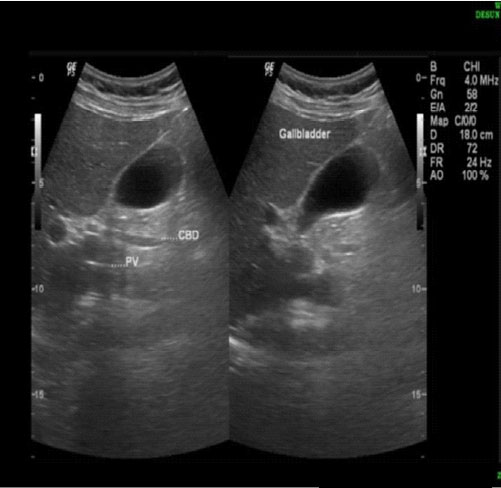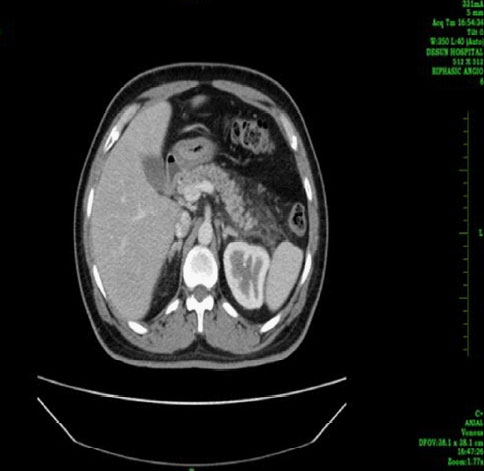
Japanese Journal of Gastroenterology Research
Case Report - Open Access, Volume 1
A case of acute pancreatitis with normal serum amylase and lipase value
*Corresponding Author: Jayanta Paul, MBBS, MD, DNB (Gastro), MNAMS
Consultant Gastroenterologist, Department of Gastroenterology, Desun Hospital and Heart Institute, Kolkata 700107, India.
Tel: (+91) 8348984088
Email: dr.jayantapaul@gmail.com
Received : May 16, 2021
Accepted : Jun 24, 2021
Published : Jun 29, 2021
Archived : www.jjgastro.com
Copyright : © Paul J (2021).
Abstract
There are several causes of acute pancreatitis (AP). In clinical practice, AP is diagnosed by presence of acute pain abdomen, elevated serum amylase and lipase value (>3 times of upper limit of normal) and ultrasonographic (USG) findings of acute pancreatitis but in only 25-50% of patients with acute pancreatitis, pancreas is visualised. In this case, 44 years gentleman was presented with acute pain abdomen, normal serum amylase and lipase value and no pancreatic abnormality in abdominal USG. After diagnosis of elevated serum triglyceride, computed tomography (CT scan) of abdomen was done to exclude hypertriglyceridemia induced AP. CT scan abdomen showed features of acute pancreatitis. Therefore, in every patient with acute pain abdomen if serum amylase and lipase value and USG abdomen are normal, serum triglyceride should be advised to rule out hypertriglyceridemia induced AP. In this case report we are going to present a case of acute pancreatitis with normal serum amylase and lipase value.
Keywords: Acute pancreatitis; hypertriglyceridemia; serum amylase; serum lipase; uncommon presentation.
Citation: Paul J. A case of acute pancreatitis with normal serum amylase and lipase value. Japanese J Gastroenterol Res. 2021; 1(2): 1006.
Introduction
Acute pancreatitis is a common cause of acute pain abdomen. In Europe and other developed nations more patients tend to have gallstone pancreatitis, whereas alcoholic pancreatitis is most common in United States. In India, prevalence of alcohol induced pancreatitis is higher than gall Stone induced pancreatitis [1-3] but other study showed opposite result [4]. Abdominal pain is the cardinal symptom which occurs in about 95% of cases of AP. Acute pancreatitis is diagnosed by following revised Atlanta criteria which includes acute pain abdomen, elevated serum amylase and/ or lipase (>3 times of upper limit of normal) radiological evidence of acute pancreatitis. But in around 20-30% cases of AP, serum amylase and lipase are normal. Abdominal ultrasonography (USG) has low sensitivity to diagnose AP. Therefore normal serum amylase and lipase along with normal USG abdomen dose not exclude acute pancreatitis in 100% cases of acute pain abdomen.
Case report
Forty four years old non diabetic, hypertensive gentleman, who was on alcohol (more than two standard drinks on alternate day) for last 2 years, was admitted with pain abdomen and nausea for last 2 days. The abdominal pain was acute, localized to upper abdomen, severe in intensity, non-radiating, lasting for 6 hours till medication for pain. He had no history of vomiting, fever, cough, breathlessness and intake of any non steroidal anti inflammatory drugs (NSAID) or any other medications causing acute pancreatitis. He also did not have any family history of hypertriglyceridemia.
Initially he was admitted in local hospital and pain abdomen was reduced after giving intravenous (IV) injection of Tramadol (50 mg) and Pantoprazole (40 mg) but after 1 hour, again he had severe pain abdomen. On next day morning he was referred to our hospital for further evaluation and management.
On admission at our hospital, he was conscious, alert, co-operative and hemodynamically stable. Pulse rate and blood pressure were 124/min and 140/96 mmHg respectively. On physical examination, she had upper abdominal tenderness without any organomegaly, no free fluid in abdomen. Respiratory system and cardiovascular system were normal in examination.
After history and physical examination, the provisional diagnoses were acute cholecystitis, acute pancreatitis (AP), peptic ulcer disease and acute coronary syndrome.
During initial admission at local hospital abdominal ultrasonography (USG), Electrocardiography (ECG), chest X-ray (PA view) and few blood investigations including amylase and lipase were done (Table1). Abdominal ultrasonography showed following abnormalities: grade I fatty liver, absence of gall stone (Figure 1), gall bladder polyp (5 mm) arising from gall bladder (GB) neck and adenomyosis. Chest X-ray and ECG were normal.
After analysis of initial reports from previous hospital, acute pancreatitis (USG abdomen showed normal pancreas, Blood amylase and lipase value were within normal range) and acute cholecystitis (USG abdomen: no features of acute cholecystitis or gall bladder stone) were excluded from provisional diagnosis.
After admission at our hospital, initially he was managed conservatively with intravenous fluid, analgesic and pantoprazole). But he again had experienced severe pain abdomen with vomiting. He underwent oesophagogastroduodenoscopy (OGD) which identified no abnormalities. Echocardiography showed concentric left ventricular hypertrophy, 65% left ventricular ejection fraction and grade I left ventricular diastolic dysfunction. Troponin I test was negative. Other blood investigations which were done at our hospital showed dyslipidemia (Table 2).
In view of very high serum triglyceride, again we have included acute pancreatitis in our differential diagnosis and advised computed tomography (CT scan) of abdomen (Figure 2 and 3) which showed bulky distal body and tail region of pancreas with peri pancreatic fat standing, no pancreatic necrosis, modified CT severity index score 2.
After CT scan abdomen report, diagnosis was confirmed. This was a case of acute pancreatitis (mild AP according to revised Atlanta classification) with normal serum amylase and lipase due to serum hypertriglyceridemia.
Patient was treated conservatively with IV fluid, analgesic, pantoprazole, rosuvastatin and fenofibrate because it was a case of mild acute pancreatitis, and discharged with symptomatically improved stable condition.
Table 1: Initial blood investigations at the time of admission at local hospital.
| Blood investigations | Test value |
|---|---|
| Haemoglobin (gm/dl) | 13.7 gm/dl |
| White blood cell (WBC) | 15100/ cmm |
| Platelet Count | 154000/ cmm |
| Packed cell volume | 40.5% |
| Creatinine | 0.65 mg/dl |
| Sodium | 135 mmol/L |
| Potassium | 3.7 mmol/L |
| Total bilirubin | 1.2 mg/dl |
| Direct bilirubin | 0.2 mg/dl |
| Aspartate aminotransferase (AST) | 27 U/L |
| Alanine aminotransferase (ALT) | 22 U/L |
| Albumin | 3.9 gm/dl |
| Globulin | 3.2 gm/dl |
| Amylase | 45 U/L |
| Lipase | 50 U/L |
| C-Reactive protein | 210.2 mg/L |
Table 2: Blood investigations at our hospital
| Blood investigations | Test value |
|---|---|
| Total cholesterol | 417 mg/dl |
| Triglyceride | 883 mg/dl |
| Low-density lipoprotein (LDL) | 119 mg/dl |
| High density lipoprotein (HDL) | 40 mg/dl |
| Total calcium | 9.9 mg/dl |
| Glycosylated haemoglobin (HbA1C) | 5.9% |
| Thyroid stimulating hormone (TSH) | 88 mIU/L |
| Triiodothyronine (T3) | 1.07 ng/ml |
| Thyroxine (T4) | 6.06 ug/dl |
Discussion
Revised Atlanta classification (2012) which includes acute pain abdomen, serum amylase or lipase value >3 times the upper limit of normal, and characteristics findings of AP seen in cross-sectional abdominal imaging is commonly used for diagnosis of acute pancreatitis [5]. In our case, initially patient had acute pain abdomen, normal serum amylase and lipase value, and normal abdominal ultrasonography (it is the initial radiological investigation for pain abdomen). CT abdomen is indicated in Patients who present with severe pancreatitis or present initially with mild to moderate pancreatitis but does not improve after several days of supportive therapy.
There are multiple causes of acute pancreatitis but in only 75%-85% of AP patients, aetiology can be identified [6]. Gall stone pancreatitis and alcoholic pancreatitis are the most common causes of acute pancreatitis [6]. Hypertriglyceridemia is the 3rd most common cause (2%-3%) for acute pancreatitis after gallstone and alcoholic pancreatitis [7].
Hypertriglyceridemia (HTG) is defined by fasting serum triglyceride level of >150 mg/dL (1.7 mmol/L). HTG is classified based on the degree of elevation as follows: Mild (150 to 199 mg/dL) Moderate (200 to 999 mg/dL) Severe HTG (1000 to 1999 mg/dL) [8]. In our case, patient had moderate hypertriglyceridemia (883 mg/dl).
Serum amylase, lipase activity is normal or low in 19–32% of cases at the time of hospital admission, secondary to chronic alcohol abuse due to pre-existing pancreatic injury and hypertriglyceridemia due to dilutional effects of the lipemia [9, 10]. Our patient also had similar findings (normal serum amylase, lipase value).
Conclusion
In conclusion, Patient with acute pain abdomen and normal serum amylase and lipase value does not exclude acute pancreatitis. Serum lipid profile including triglyceride should be advised in every patient with acute pain abdomen to exclude hypertriglyceridemia induced acute pancreatitis.
References
- Mukherjee D, Bhakta S, Lahiry S, et al. Demographic profile of Acute Pancreatitis in Eastern India: A Single Centre Experience. Asian j. med. Sci 2017; 8: 24-29.
- Negi N, Mokta J, Sharma B, et al. Clinical Profile and Outcome of Acute Pancreatitis: A Hospital-Based Prospective Observational Study in Subhimalayan State. J Assoc Physicians India. 2018; 66:22–24.
- Avadhani KG, Shirshetty AK. An epidemiological study of acute pancreatitis in rural population. J Med Sci Health 2016; 2:25-29.
- Nesvaderani M, Eslick GD, Vagg D, et al. Epidemiology, aetiology and outcomes of acute pancreatitis: A retrospective cohort study. Int J Surg. 2015;23:68–74
- Banks PA, Bollen TL, Dervenis C, et al. Classification of acute pancreatitis—2012: revision of the Atlanta classification and definitions by international consensus. Gut 2013; 62:102–111.
- Spanier BW, Dijkgraaf MG, Bruno MJ. Epidemiology, aetiology and outcome of acute and chronic pancreatitis: An update. Best Pract Res Clin Gastroenterol. 2008; 22: 45–63.
- Fortson MR, Freedman SN, Webster PD 3rd. Clinical assessment of hyperlipidemic pancreatitis. Am J Gastroenterol. 1995; 90:2134–2139.
- Berglund L, Brunzell JD, Goldberg AC, et al. Evaluation and treatment of hypertriglyceridemia: an Endocrine Society clinical practice guideline. J Clin Endocrinol Metab 2012; 97:2969.
- Matull WR, Pereira SP, O'Donohue JW. Biochemical markers of acute pancreatitis. J Clin Pathol. 2006; 59:340–344.
- Yadav D, Agarwal N, Pitchumoni C S. A critical evaluation of laboratory tests in acute pancreatitis. Am J Gastroenterol 2002; 97: 1309–1318.



